Planning a Small Home Orchard
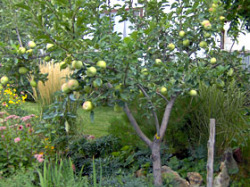
Dwarf apple trees are small enough to fit in any landscape.
With rising food and gas prices, more and more gardeners are looking for ways to reduce household costs and grow more of their own food. Once you start along this path, sooner or later the idea of growing fruit trees pops into your head. And why not? Fruit trees are prolific, bearing for years. With dwarf varieties you don't have to own acres of land to grow them. Also, with new disease resistant varieties, controlling pests is a little easier. But don't make the mistake of thinking that fruit trees are carefree. They are not a “plant it and forget about it” type of crop. However, with a little attention they can grow and fruit for years, providing food for you, your neighbors, and wildlife.
Before you start digging holes and ordering fruit trees from around the country, you'll need to spend some time planning. Here are some the considerations you should keep in mind when planning your home orchard.
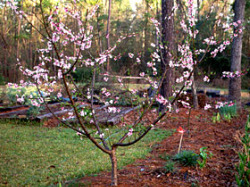
Fruit trees offer beautiful flowers in spring as well as tasty fruits in summer.
Site selection before you even start drooling over the photos in the fruit mail order catalogs, take an honest look at your property. Fruit trees need at least 8 hours of direct sun a day to grow and fruit their best. Make sure tall trees, other buildings, or your house don't block the sun, especially as it dips lower on the horizon come August. Note where power lines are overhead. Don't grow large fruit trees under power lines where you'll have to prune them to prevent them from growing into the lines.
In northern areas, plant hardy fruit trees such as apples, American plums, and sour cherries on a south-facing slope to receive extra heat. Avoid planting early blooming, more cold sensitive fruits, such as peaches and apricots, in a south-facing area because they may bloom too early and the blossoms will get killed by frost. A north-facing slope is better for these fruits and for all fruits growing in hot summer areas. In either case, select a sloping location where the cold air will drain into the low lands and a late spring frost won't harm your blossoms.
Your home orchard doesn't have to be planted all together. You can plant some apples in the backyard, a few pears on the side yard, perhaps a cherry in the front lawn, and some figs in a container. I even have Italian relatives who plant dwarf fruit trees in their vegetable and flower garden. A well-drained, fertile soil is ideal, but fruit trees can be grown in less than ideal soils as long as the soil is well-drained and you add compost and fertilizer annually.
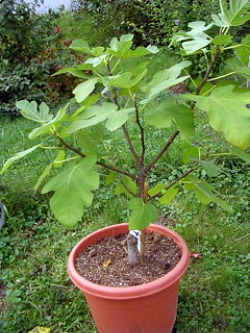
If you don't have room for fruit trees in the yard, plant fruits such as figs in containers.
Tree Selection What to grow will depend on where you live and how much space you have. Determine the hardiness zone for your area and select fruit trees that will grow well there. The hardiness zone isn't a hard and fast rule. If you can create microclimates in your yard by planting near buildings or fences that protect the trees from the winter's cold, often you can grow a tree that may be marginally hardy in your area. On the other hand, if your trees are in an exposed spot, even a variety that's hardy in your area may suffer winter injury. If you live in a warm winter area you'll need to know the chill hours that variety requires to fruit. Some areas are too warm in the winter to grow all types of fruits.
Another consideration is the size of the tree. Most fruit trees come in varieties that are dwarf, semi-dwarf, and standard. Dwarf trees stay about 8- to 10-feet tall and are perfect for small yards. There are even dwarf fruit trees, such as columnar apples, figs, and pomegranates, that fit well in containers, allowing you to move them as needed. Semi-dwarf trees grow about 10- to 15-feet tall and are more productive than dwarfs. Standard-sized trees grow 20 feet or more and are most productive. Sketch out how much room you have in your yard to determine which type of fruit tree you should purchase. The ultimate height of the tree is a good indication as to how far apart they should be planted.
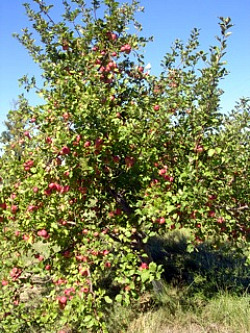
Full-sized trees produce the most fruit, but take up the most amount of space.
The dwarf and semi-dwarf trees are either grafted or “genetic” dwarfs. Grafted trees have a hardy rootstock with the desired variety grafted onto it. Genetic dwarfs have been bred to grow in a dwarf form (usually less than 8 feet tall) on their own rootstock. Genetic dwarfs are now more widely available and produce better quality fruit than earlier versions.
Variety Selection Another consideration is the variety of fruit tree you're growing. Not only is it important to grow varieties that taste great and are productive, but you also have to know a little about pollination. Most fruit trees grow best with at least two different varieties planted. The varieties should bloom roughly at the same time in spring and have pollen that's compatible. Check fruit tree catalogs for the varieties that can pollinate each other. Some fruits, such as apricots and peaches, and some special varieties, such as 'Northstar' sour cherry, and 'Improved Meyer' lemon, are self-fertile, so you only need one tree to get fruit. Look for self-fertile fruits and varieties if you have limited space.
To reduce the maintenance time and costs, select varieties that are disease resistant, such as 'Jonafree' and 'Liberty' apples. These two varieties are resistant to apple scab disease. This will help you reduce the need for spraying to produce a good crop.
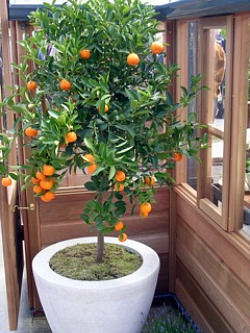
Microclimates can allow you to grow fruits, such as citrus, in regions where they normally may not thrive.
Planting Buy trees locally already potted in a container or order them bareroot from a mail-order catalog. Mail-order catalogs will offer a greater selection of trees. Ideally, select from companies in your geographic area. They will be more familiar with varieties that grow well in your region. Order trees for a spring or fall planting depending on where you live. Spring planting in best in the North, while fall planting is fine for warm winter areas (USDA zone 7 and warmer). Plant your trees as soon as possible after purchase or arrival. It's best to dig the holes and amend the soil before they arrive so you're ready for the trees. If you are planting container plants, you should wait until you have the plants to measure the rootball so you don’t dig the hole too deep.
Most commercial tree grower prune the trees for you before shipping, so you won't have to prune until next winter. On dwarf trees you may start getting fruits in a few years. Standard sized trees take longer to start bearing.
If you plant your fruit trees following these steps and keep them well watered, you’ll be on your way to having delicious, home-grown fruits to enjoy.
Check out the Food Garden Guide for the specifics on growing individual fruits. Look up the websites of fruit trees nurseries in your area in our Edible Resource Guide. Enjoy the fruits!